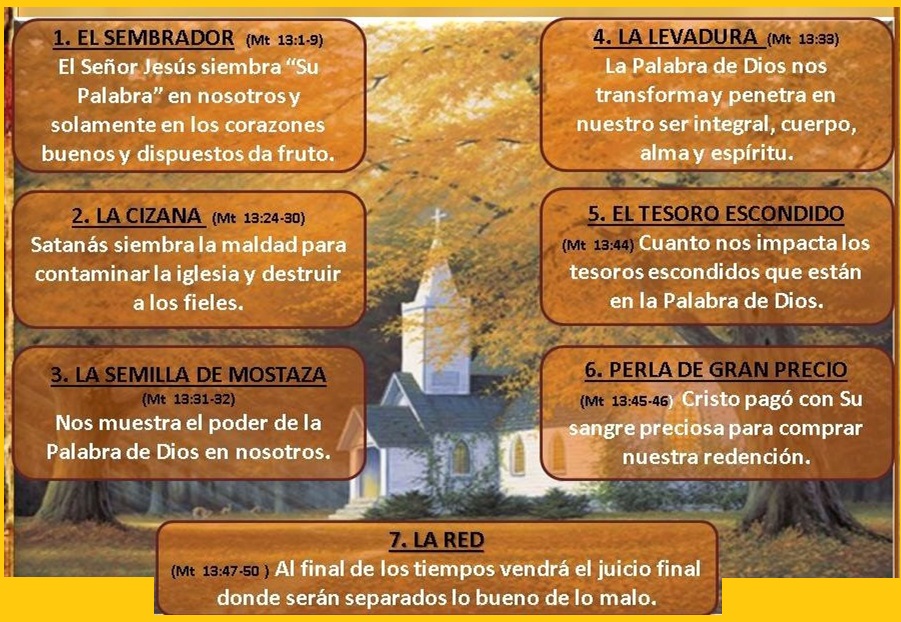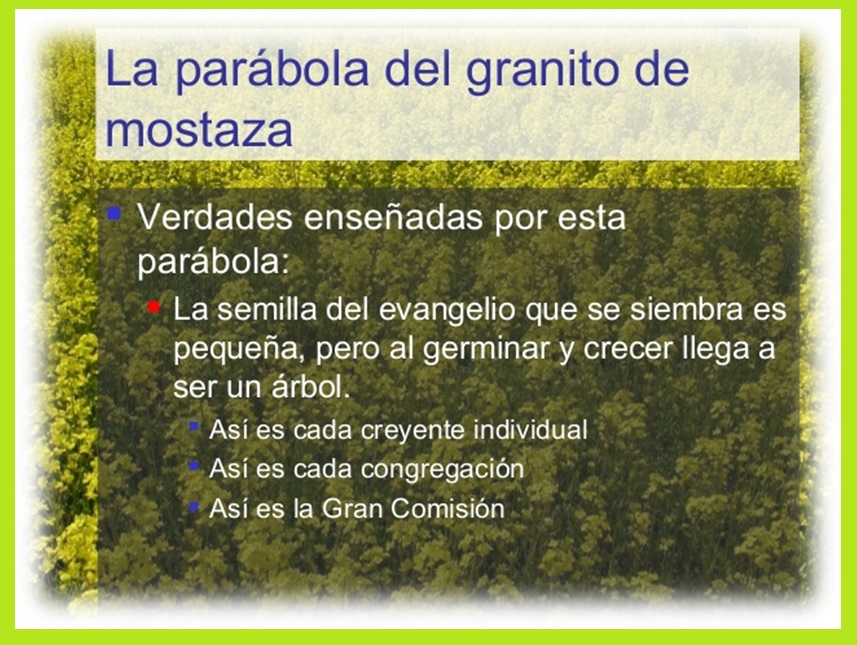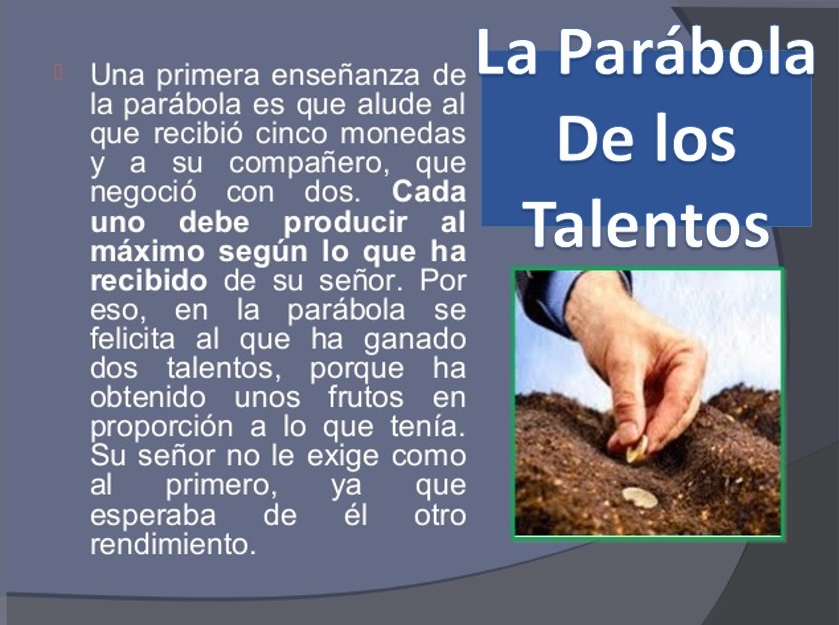Parables of Jesus, are brief stories with which the Lord taught the people and his disciples. So that they could understand the message of God and his Kingdom, through comparative, symbolic, reflective and credible stories. These teachings are found in the Gospels of the Bible.

Parables of Jesus
Jesus Christ during his ministry here on earth, on certain occasions transmitted the message of the Kingdom of God to the people and his disciples through parables. The parables of Jesus are his teachings concentrated in short stories that reveal a spiritual truth. He made these stories in a symbolic and comparative way. So that the people who listened to it could reflect and discover the true message contained in them.
The comparisons that Jesus made in his parables were about credible events or situations. Most of them in simple examples and everyday life to make it easier to understand it. The parables were told by Jesus to his disciples and to the crowd that followed him at all times to listen to him or for an opportunity to touch him, aware of the power he exercised.
Why does Jesus teach with parables?
However, the message of Jesus told through the parables was not understood by all who heard it. On one occasion the disciples asked the teacher why he used this way of teaching and he replied that his message would only be understood by those who had faith in him and in God his father, Matthew 13: 9 -13 ( ALT)
9 If you really have ears, pay close attention!” 10 The disciples came to Jesus and asked him, "Why do you teach people through examples (parables)? 11 Jesus said to them, “I allow you to know the secrets of the kingdom of God, but not others. 12 For those who know something about the secrets of the kingdom are allowed to know much more. But those who do not know much about the secrets of the kingdom, God will cause them to forget even the little they know. 13 I teach people by example; thus, no matter how much they look, they will not see anything, and no matter how much they hear, they will not understand anything either.
Those with a hardened heart and who would not have accepted God no matter how much they listened, would never understand the secrets of the kingdom of God, and no matter how hard their eyes were open, they could never see it. These words of Jesus fulfilled what God said through the prophet Isaiah, in Isaiah 30: 9-14.
The explanation given by Jesus to his disciples is essential to understand this form of teaching. Making it very clear that the secrets of the Kingdom of God would only be revealed to believers. So that these could cultivate and grow in the faith of Christ Jesus.
Where are these Parables found?
The parables of Jesus are found in the canonical gospels of the Bible. They are generally found in the Synoptic Gospels of Matthew, Mark, and Luke, where many of these parables are repeated. While the evangelist John only recounts two parables himself. The parable of the Fold and the Good Shepherd, in chapter 10, John 10: 1-18; and the parable of the true vine in chapter 15, John 15:1-17.
Parables of Jesus Summary
Apart from the two parables of John in the other three Gospels, 43 parables of Jesus can be found in total. Which are summarized as follows: Ten parables of Jesus are repeated in the three synoptic gospels of Matthew, Mark and Luke. These 10 are the Parables of or of:
- Lamp, Matthew 5: 13-16 – Mark 4:21-23 – Luke 8:16-18 – Luke 11: 33-36
- New wine and old wineskins, Matthew 9: 16-17 – Mark 2: 21-22 – Luke 5:36-39
- Strong man with his hands tied, Matthew 12: 29-32 – Mark 3: 27-29 – Luke 11: 21-23
- The truths of Jesus, Matthew 12: 48-50 – Mark 3: 33-35 – Luke 8: 20-21
- Sower, Matthew 13: 1-9 – Mark 4: 1-9 – Luke 8: 4-8
- The mustard seed, Matthew 13: 31-32 Mark 4,30, 32-13,18, Luke 19, XNUMX-XNUMX
- Little boy, Matthew 18: 1-10 – Mark 9: 35-37 – Luke 9: 46-48
- The homicidal vinedressers, Matthew 21: 33-44 – Mark 12: 1-11 – Luke 20: 9-18
- Fig tree, Matthew 24: 32-35 – Mark 13: 28-31 – Luke 21: 29-31
- Watchful servant, Matthew 24: 42-44 – Mark 13: 34-37 – Luke 12: 35-40
From the Gospel of Matthew
The evangelist Matthew, in addition to those shared, describes eleven parables of Jesus, which can only be found in his gospel. These are the Parables of or of:
- The straw and the beam, Matthew 7:1-5
- Wheat and tares, Matthew 13: 24-30
- Hidden treasure, Matthew 13:44
- The pearl of great price, Matthew 13:45-46
- The network Matthew, 13: 47-50
- Family man, Matthew 13: 51-52
- Official who did not want to forgive, Matthew 18: 23-35
- Workers in the vineyard, Matthew 20:1-16
- The two sons, Matthew 23:13-36
- The ten virgins, Matthew 25:1-13
- Final Judgment, Matthew, 25: 31-46
From the Gospel of Mark
The evangelist Mark, in addition to those shared, describes a parable of Jesus, which can only be found in his gospel. This Parable is: The Parable of the growth of the seed in Mark 4:26-29 (TLA)
26 Jesus also gave them this other comparison: “Something happens with the kingdom of God like what happens when a man sows a seed in the ground. 27 It does not matter whether that man is asleep or awake, or whether he is night or day; the seed is always born and grows without the peasant understanding how. 28 The earth first produces the stem, then the ear, and finally the seeds. 29 And when harvest time comes, the farmer collects the seeds.”
From the Gospel of Luke
The evangelist Luke, in addition to those shared, describes twelve parables of Jesus, which can only be found in his gospel. These are the Parables of or of:
- The two debtors, Luke 7:41-47
- Good Samaritan, Luke 10: 25-37
- Unwelcome friend, Luke 11: 5-10
- Rich fool, Luke 12: 16-21
- The fruitless fig tree, Luke 13:6-9
- Parable of the Prodigal Son, Luke 15: 11-32
- The Lost Coin, Luke 15:8-10
- Cunning Steward, Luke 16:1-8
- Rich man and Lazarus, Luke 16: 19-31
- Useless servant, Luke 17:7-10
- Wicked judge and importunate widow, Luke 18:1-8
- Pharisee and tax collector, Luke 18:9-14
Parables of Jesus Repeated in Matthew and Luke
Nine of the 43 parables of Jesus are repeated in the Gospels of Matthew and Luke. These nine are not described by Mark in his gospel. The nine parables are those of or of:
- Respondent, Matthew 5: 21-26 – Luke 12: 57-59
- Birds, Matthew 6: 25-26 – Luke 12: 22-26
- The lilies, Matthew 6: 28-34 – Luke 12: 27-31
- The house on the rock, Matthew 7: 24-27 – Luke 6: 47-49
- The tree and its fruits, Matthew 7: 15-20 – Luke 6: 43-45,
- Leaven, Matthew 13:33 – Luke: 13: 20-21
- Wedding banquet, Matthew 22: 1-14 – Luke 14: 15-24
- The Lost Sheep, Matthew 18:12-14 – Luke 15:1-7
- The talents, Matthew 25: 14-30 – Luke 19: 11-37
In addition to the canonical gospels of the Bible, the parables of Jesus can also be found in those considered apocryphal. As are the cases of the Gospels of Thomas and James. Specifically in the Gospel of Thomas there are 17 of the aforementioned parables.
Themes that Link Some of the Parables
In the gospels some parables have a common message or theme that connects them. Some can be found consecutively. In the same way they can be in a single gospel or repeated in one or more of them. Let's see what these cases are below:
-The Parable of the Mustard Seed and The Parable of the Yeast: The central and similar theme between both parables is the expansion of the kingdom of God.
-Parable of the hidden treasure and the parable of the precious pearl: The message contained in these two parables is the value that the kingdom of God should have in our lives. God wants Jesus Christ to be our most appreciated asset, our true treasure.
-The Parable of the Lost Sheep, the Parable of the Lost Coin, and the Parable of the Prodigal Son: This trio of parables from the Gospel of Luke contain the central theme of repentance as a fundamental action to enter the Kingdom of Heaven. Jesus lives in hearts that have shown genuine repentance.
-The parable of the faithful servant and the parable of the ten virgins: These two parables contain an eschatological theme, specifically about the last times of the second coming of the Lord. For this, the Lord advises to watch at all times, in order to be prepared for his arrival.
-Four parables such as the tares, the rich fool, the fig tree and the parable of the barren fig tree: They have in common that all four deal with eschatological themes. Each of them one in specific.
Some central themes of independent parables are, for example:
- The Parable of the Unprofitable Servant: Faith and Faithfulness to God
- The Good Samaritan: Love and Mercy
- The Parable of the Watchful Servant: Remain in Faith and Prayer.
Some Parables of Jesus and their Meaning
The term parable refers to a literary expression that is based on an allegorical narrative; that serves to teach in a comparative way a subject that is not the explicit one. The parable then has a didactic objective, the same purpose that Jesus had when telling them to his disciples and to the people.
Jesus through his parables sought to teach the deepest spiritual truths, in a language that could reach all people. This simple teaching style contrasted with the complex language of the Jewish scholars of the day. Here are the meanings of some Parables
The Parable of the Yeast
The parable of the leaven is one of the nine that can be found both in the Gospel of Matthew and in that of the Evangelist Luke. Let's see the texts of this parable below and then the meaning of the message:
Matthew 13:33 (NIV): 33 Jesus gave them one more comparison: “The same thing happens with the kingdom of God as with flour. When a woman puts a little leaven in it, that little bit makes the whole lump rise.”
Luke 13:20-21 (NIV): 20 Jesus also said to them: « With what else can I compare the kingdom of God? 21 It can be compared to what happens when a woman puts a little leaven in a heap of flour. That little bit makes the whole thing grow!sa!”
Meaning
The theme of the parable of the leaven is similar to that of the mustard seed, which is the expansion of the kingdom of God. Jesus' comparison of leaven with the kingdom of God. It is basically due to the effect that the yeast produces once it is placed in the flour. Yeast makes the dough rise or grow in volume. The same thing happens when his disciples and followers take the good news of the gospel of Jesus to the world. Which will produce the transformation of men and women in all corners of the world, multiplying and making the kingdom of God grow in the nations. It is a blessing to be a servant of the Lord, to be able to exercise the function of yeast in the region in which we live. Make the yeast reach the portions of flour that need the message of salvation of Christ Jesus.
Parable of the Useless Servant
The parable of the Useless Servant, also known as that of the absent master, can only be found in the Gospel of Luke. Let's see the content of this parable below and then the meaning of the message:
Luke 17:7-10 (NIV) 7 »None of you who has a slave, says to him: “Come, sit down to eat”, when he returns from working in the field, or taking care of the sheep. 8 Rather, he tells her: “Make me dinner. I want you to be attentive to serve me, until I finish eating and drinking. Later you can eat and drink yourself.” 9 he also does not thank you for complying with his orders. 10 So when you have done everything God commands you, don't expect him to thank you. Rather, think: “We are just servants; we have done no more than fulfill our obligation.”
Meaning
The message contained in this parable is the value that the Lord Jesus gives to our faith and fidelity to God. In addition to our voluntary disposition in the faithful fulfillment of what he demands us to do. Even striving to do more than the bare minimum required, go the extra mile down the road.
This parable of Jesus means that the fact that we fulfill the assigned duties. It is not a reason for vainglory, nor to demand gratitude or climb positions in his kingdom. Because the true merit is in doing it for him, in him and for him.
The Lord Jesus wants us to understand that pleasing him is a task that goes beyond simply fulfilling it. He teaches us with this message that it is a task that must be done from the heart and in permanent communion with him and our heavenly Father.
The Parable of the Hidden Treasure
The Parable of the Hidden Treasure is one of eleven parables that can only be found in the Gospel of Matthew. Let's see the content of this parable below and then the meaning of the message:
Matthew 13:44 (NIV): 44 “With the kingdom of God, the same thing happens as with a treasure hidden in a piece of land. When someone finds it, they hide it again; and then he goes very happily to sell everything he has to buy the land and keep the treasure for himself.
Meaning
This parable tells us that by finding Jesus, we find the most precious or valuable treasure. So it is well worth selling or leaving everything we thought was valuable, in order to acquire or allow Jesus to enter our hearts. Because where your treasure is, there your heart will be. Let us remember the words of Jesus in Matthew 19:29 (TLA)
29 And all who, by following me, have left their wives and their children, their brothers or their sisters, their father or their mother, their house or a piece of land, will receive a hundred times what they left, and they will also have eternal life
Jesus tells us that we cannot fix our eyes on earthly things. Because they can be a cause of stumbling, to reach the true eternal riches, the heavenly ones. We must then change our old way of thinking. Stop worrying about material riches, tribulations, worries of this world, etc. To be able to rest in Jesus who is our greatest treasure. Keep reading:
- Modesty: biblical meaning, how to cultivate it, and more
- how to study the bible



